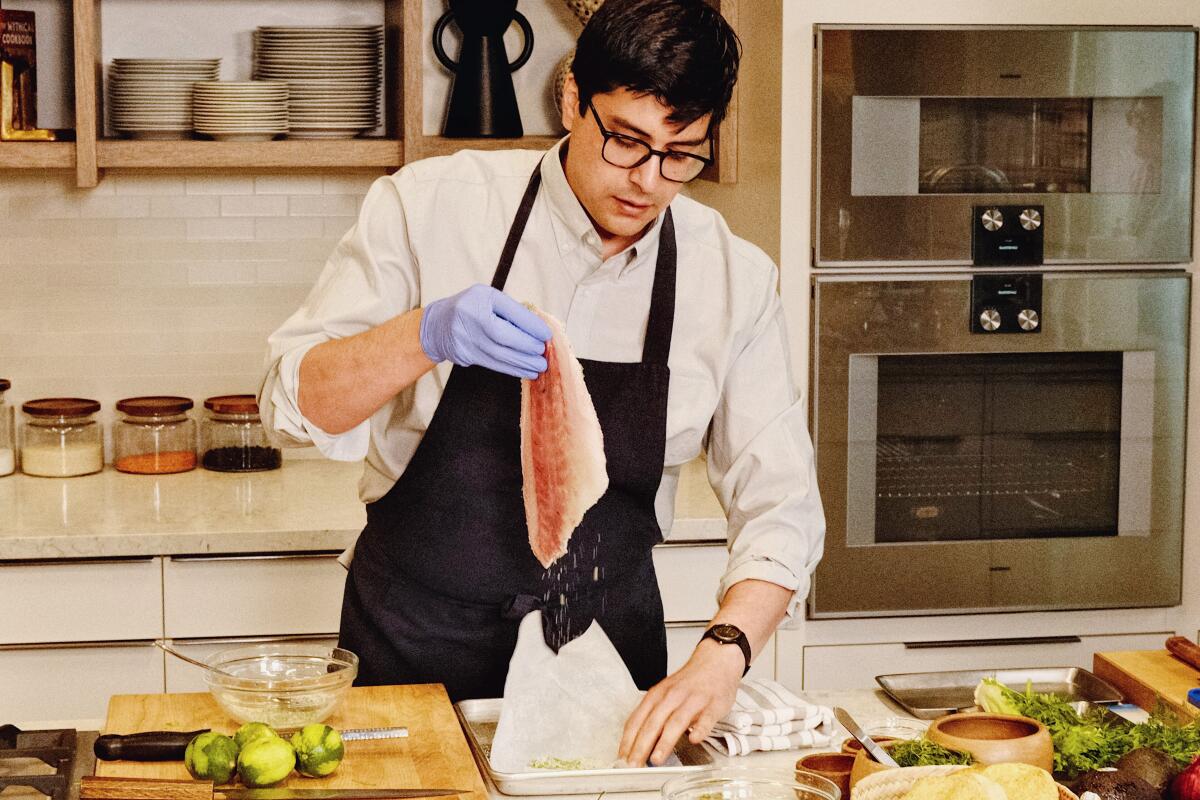
Damian chef Jesus “Chuy” Cervantes gives us his pointers for making seasonal ceviche.
- Share via
When it comes to making ceviche, “It’s meant to be a lot of fun,” says Jesus “Chuy” Cervantes, chef de cuisine of Damian in downtown L.A.’s Arts District.
It’s a dish that the Mexican fine-dining restaurant has had on its menu since its opening in fall 2020, though the ingredients shift with the seasons.
“It’s usually something you’re going to have in a festive environment, or if not, perhaps for a hangover, which means you had a festive night,” says Cervantes.
The versatility of ceviche makes it possible to eat nearly every day without getting bored.
Here are Cervantes’ tips for making the best possible ceviche.
The star ingredient in any ceviche is the fish. “You generally want to use a softer, white-fleshed fish that can stand up to the vegetables but still break down some in the citrus juice and become soft enough to enjoy with the other vegetables incorporated in the dish.”
Cervantes used a kanpachi filet sourced from Baja California, but the main priority is to buy fresh fish from local fishermen and markets. When selecting a fish, make sure there are no discolorations, no off-looking cuts or anything that would indicate that it sustained injuries during its capture.
“The way you can see that is if there are broken-up pieces in the flesh or bloody-looking chunks inside of the flesh,” says Cervantes. “That could equate to the product not being as high-quality as you want.”


1. Damian chef de cuisine Chuy Cervantes uses a kampachi filet for this ceviche, but you can use any locally sourced white-flesh fish that can stand up to the vegetables but become soft enough in the citrus marinade to enjoy with the avocado and other vegetables in the dish. 2. Cervantes “cures” the fish with sugar, salt and lime zest. (Stephanie Breijo/Los Angeles Times)
Next, cure the fish with sugar, salt and lime zest. Stir the mixture until there are no clumps and it’s a fine dust. Coat both sides of the fish generously and put it in the refrigerator to cure.
“The idea with the cure is to release as much moisture from the fish while at the same time flavoring it, and at the end you end up with a firmer texture,” Cervantes says.
Cervantes recommends using red onions in ceviche. “There’s a bit more bite, a bit more spice to it, and at the end it mellows out and has that sweetness that we all love. White onion tends to get lost a bit.”
He also loves celery for ceviche. Use the inner part of the stalk that’s tender and less fibrous than the outer ribs. The leaves can be used as garnish.
As a rule, no ingredient should be larger than the fish. “The fish should be the center point of our ceviche,” Cervantes says.
Chef Mary Sue Milliken ups the flavor for pork ribs with fennel, herbs and spices.
Avocado is the only ingredient that’s cut the same size as the fish. This allows the avocado cubes to contrast with the texture of the fish, Cervantes says. When selecting an avocado, make sure that it’s firm, not too soft and without dimples or bruises. The chef recommends removing the stem to check the fruit’s ripeness. If it’s bright green, it needs more time. If the color appears ripe, then it’s ripe all the way through.
Young ginger, which is less fibrous and sweeter than ginger that’s grown toward the end of the season, is preferred for ceviche. But if you can’t find young ginger, you also can boil your ginger, which will rinse the astringent flavor.
Once the fish is ready, brush off the cure and cut it into strips, being sure to slice off the dark muscle that’s known as the “blood line,” which runs close to the blood that flows along the fish’s spine. It’s fine to eat but imparts a fishier flavor that can overpower ceviche.
When combining the ceviche ingredients, vigorously stir the olive oil with a touch of salt until it is emulsified. This way, when you add the lime juice, the oil won’t separate from the citrus.
This style of fresh ceviche is best made to order and shouldn’t sit for too long. “The lime juice will not only cook the fish, but it will also start to soften all the rest of your vegetables and you won’t have that really nice crunchy ceviche that we like,” Cervantes says.
After garnishing with celery leaves and cilantro, serve the ceviche with salsas, tortilla chips, crackers or on a tostada. Or do as Damian chef-owner Enrique Olvera does and eat it in a tortilla like a taco.
Damian's Summer Ceviche
Check out Damian at Food Bowl on Sunday, Sept. 22, noon to 3 p.m. at the Paramount Pictures Studios backlot.
Chef demos and cookbook signings, along with tastes and sips from 100-plus restaurants and drink purveyors, are part of L.A. Times Food Bowl 2024, taking place at Paramount Pictures Studio Backlot on Sept. 20, 21 and 22.
More to Read
Eat your way across L.A.
Get our weekly Tasting Notes newsletter for reviews, news and more.
You may occasionally receive promotional content from the Los Angeles Times.















